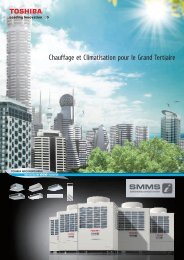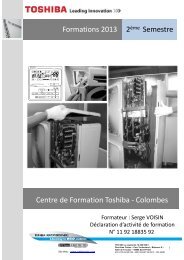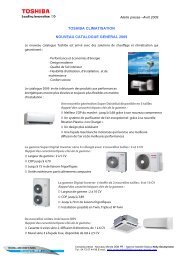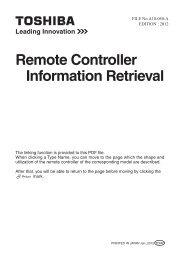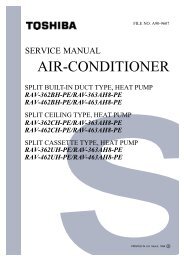Super Multi System - Toshiba
Super Multi System - Toshiba
Super Multi System - Toshiba
You also want an ePaper? Increase the reach of your titles
YUMPU automatically turns print PDFs into web optimized ePapers that Google loves.
Adding the refrigerant<br />
After the airtight test, replace the vacuum pump with a refrigerant bottle to charge the system.<br />
Calculating the additional refrigerant required<br />
The <strong>Super</strong> <strong>Multi</strong> contains sufficient refrigerant to operate an installation having 5 metres of pipework (when<br />
delivered). The refrigerant amount at shipment does not include the refrigerant needed for the piping - so<br />
first calculate this amount, and then add it.<br />
The total refrigerant charge must be calculated by the weight and within a tolerance of ± 50 g.<br />
Refrigerant charge amount shipped from the factory:<br />
Outdoor unit model name MAR-F105HTM8-PE<br />
Charging amount (kg) 19.0<br />
Maximum gas charge (kg) 36.3<br />
The amount of additional refrigerant is calculated from the actual length of the liquid pipe.<br />
To calculate the additional refrigerant volume, refer to the diagram and follow the steps below:<br />
(i) The main pipe length is taken as the addition of pipes X, Y and Z.<br />
(ii) The sub pipe length is taken as the addition of the two longest of the four (if 4 <strong>Multi</strong> Controllers).<br />
(iii) The branch pipe lengths must be individually calculated using the 8 longest pipes.<br />
(iv) Do not attempt to add gas above the maximum shown in the table above.<br />
(v) For systems with one <strong>Multi</strong> Controller ignore the sub-pipe section within the additional gas charge<br />
calculation.<br />
(vi) When using three <strong>Multi</strong> Controllers, it is important that a reducer is used on the pipework for the third<br />
<strong>Multi</strong> Controller. Pipework before the reducer is classed as main piping and after as sub piping.<br />
Charging the system<br />
Refrigerant pipe installation<br />
Charging the system with additional refrigerant<br />
Keeping the outdoor unit valve closed, charge the refrigerant from the service port on the liquid side.<br />
If the specified amount of refrigerant cannot be charged - fully open all the outdoor unit’s valves, then<br />
perform the cooling operation with the valve at the gas side slightly closed.<br />
If leaks cause a shortage of refrigerant - recover the refrigerant from the system, and recharge with<br />
new refrigerant to the total refrigerant charge.<br />
Prolonged operation with either an overcharge or deficiency in refrigerant will lead to a loss of<br />
performance, increased running costs and will cause damage to the machine. Warranty will be void.<br />
71



